MBA 5501 Advanced Marketing: BMW Case Study Analysis
VerifiedAdded on 2023/02/13
|37
|7936
|50
Case Study
AI Summary
This case study analyzes BMW's marketing strategies and consumer buying behavior, focusing on the application of the consumer-buying process. It examines how BMW segments and targets consumers based on Maslow's hierarchy of needs, detailing the company's approach to product development, feature definition, and brand positioning across its different product lines (MINI, BMW, and Rolls-Royce). The study explores BMW's strategies for building consumer loyalty, including loyalty programs and social media engagement. Furthermore, it touches upon how data analytics is employed at BMW to understand consumer behavior, and make high-involvement decisions. The case study also considers the impact of globalization on BMW and the importance of factors such as product importance, functional and psychological risk, and emotional value in consumer purchase decisions. The document is contributed by a student and published on Desklib, which offers AI-powered study tools and resources for students.

1
BMW Case Study
Andrey, Wu
Columbia Southern University
MBA 5501 Advanced Marketing
Dr. Jon Crispin
August 29, 2021
BMW Case Study
Andrey, Wu
Columbia Southern University
MBA 5501 Advanced Marketing
Dr. Jon Crispin
August 29, 2021
Paraphrase This Document
Need a fresh take? Get an instant paraphrase of this document with our AI Paraphraser
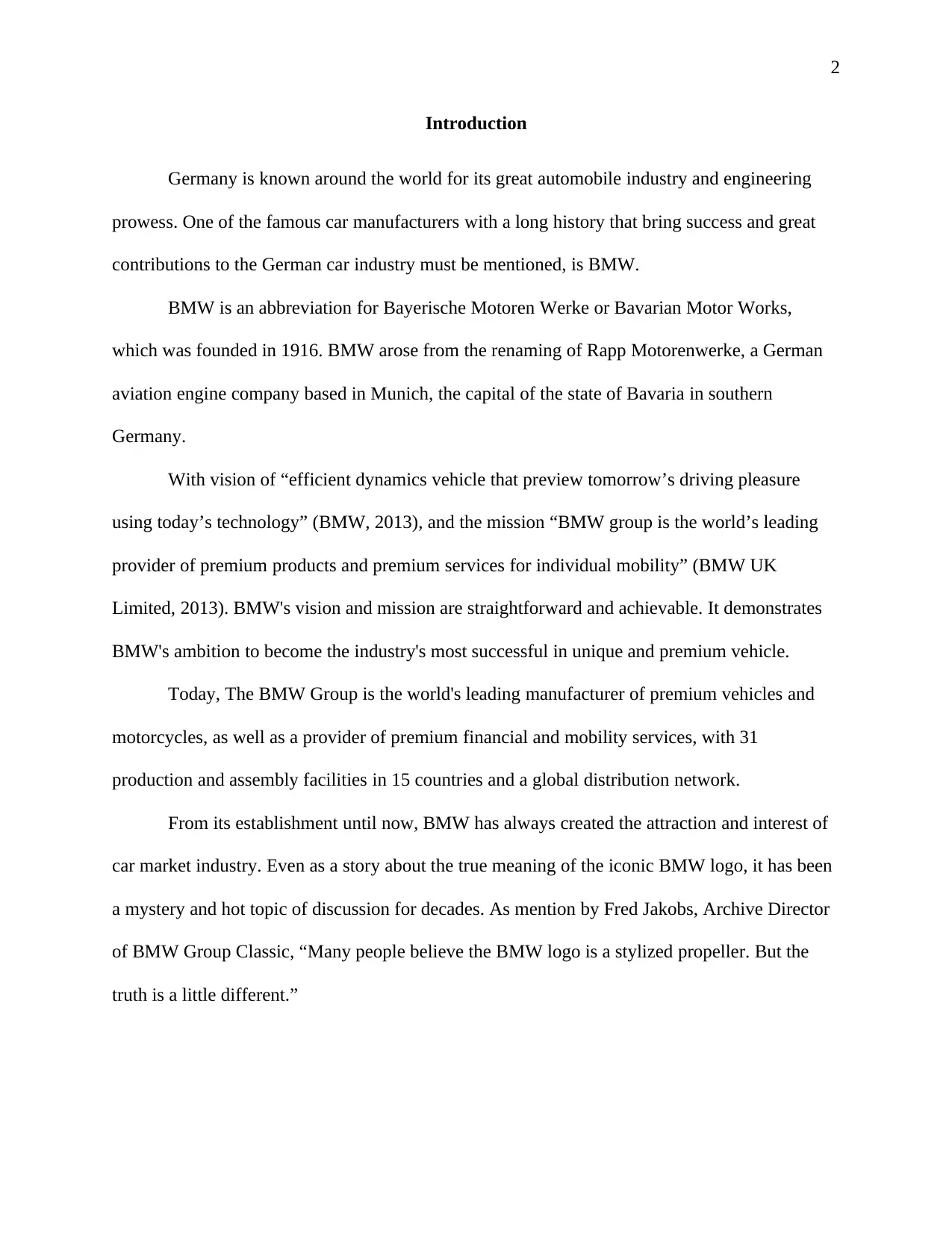
2
Introduction
Germany is known around the world for its great automobile industry and engineering
prowess. One of the famous car manufacturers with a long history that bring success and great
contributions to the German car industry must be mentioned, is BMW.
BMW is an abbreviation for Bayerische Motoren Werke or Bavarian Motor Works,
which was founded in 1916. BMW arose from the renaming of Rapp Motorenwerke, a German
aviation engine company based in Munich, the capital of the state of Bavaria in southern
Germany.
With vision of “efficient dynamics vehicle that preview tomorrow’s driving pleasure
using today’s technology” (BMW, 2013), and the mission “BMW group is the world’s leading
provider of premium products and premium services for individual mobility” (BMW UK
Limited, 2013). BMW's vision and mission are straightforward and achievable. It demonstrates
BMW's ambition to become the industry's most successful in unique and premium vehicle.
Today, The BMW Group is the world's leading manufacturer of premium vehicles and
motorcycles, as well as a provider of premium financial and mobility services, with 31
production and assembly facilities in 15 countries and a global distribution network.
From its establishment until now, BMW has always created the attraction and interest of
car market industry. Even as a story about the true meaning of the iconic BMW logo, it has been
a mystery and hot topic of discussion for decades. As mention by Fred Jakobs, Archive Director
of BMW Group Classic, “Many people believe the BMW logo is a stylized propeller. But the
truth is a little different.”
Introduction
Germany is known around the world for its great automobile industry and engineering
prowess. One of the famous car manufacturers with a long history that bring success and great
contributions to the German car industry must be mentioned, is BMW.
BMW is an abbreviation for Bayerische Motoren Werke or Bavarian Motor Works,
which was founded in 1916. BMW arose from the renaming of Rapp Motorenwerke, a German
aviation engine company based in Munich, the capital of the state of Bavaria in southern
Germany.
With vision of “efficient dynamics vehicle that preview tomorrow’s driving pleasure
using today’s technology” (BMW, 2013), and the mission “BMW group is the world’s leading
provider of premium products and premium services for individual mobility” (BMW UK
Limited, 2013). BMW's vision and mission are straightforward and achievable. It demonstrates
BMW's ambition to become the industry's most successful in unique and premium vehicle.
Today, The BMW Group is the world's leading manufacturer of premium vehicles and
motorcycles, as well as a provider of premium financial and mobility services, with 31
production and assembly facilities in 15 countries and a global distribution network.
From its establishment until now, BMW has always created the attraction and interest of
car market industry. Even as a story about the true meaning of the iconic BMW logo, it has been
a mystery and hot topic of discussion for decades. As mention by Fred Jakobs, Archive Director
of BMW Group Classic, “Many people believe the BMW logo is a stylized propeller. But the
truth is a little different.”
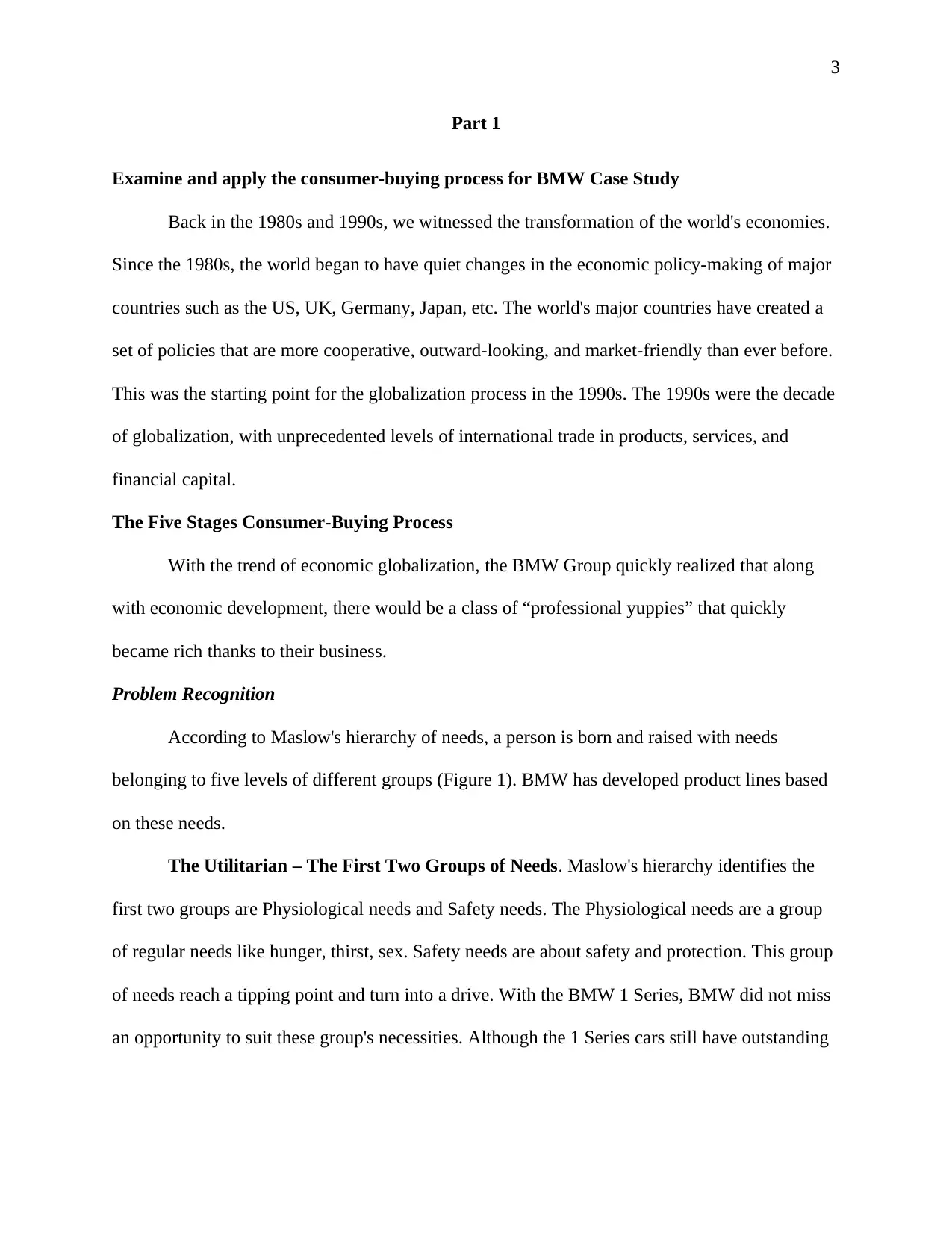
3
Part 1
Examine and apply the consumer-buying process for BMW Case Study
Back in the 1980s and 1990s, we witnessed the transformation of the world's economies.
Since the 1980s, the world began to have quiet changes in the economic policy-making of major
countries such as the US, UK, Germany, Japan, etc. The world's major countries have created a
set of policies that are more cooperative, outward-looking, and market-friendly than ever before.
This was the starting point for the globalization process in the 1990s. The 1990s were the decade
of globalization, with unprecedented levels of international trade in products, services, and
financial capital.
The Five Stages Consumer-Buying Process
With the trend of economic globalization, the BMW Group quickly realized that along
with economic development, there would be a class of “professional yuppies” that quickly
became rich thanks to their business.
Problem Recognition
According to Maslow's hierarchy of needs, a person is born and raised with needs
belonging to five levels of different groups (Figure 1). BMW has developed product lines based
on these needs.
The Utilitarian – The First Two Groups of Needs. Maslow's hierarchy identifies the
first two groups are Physiological needs and Safety needs. The Physiological needs are a group
of regular needs like hunger, thirst, sex. Safety needs are about safety and protection. This group
of needs reach a tipping point and turn into a drive. With the BMW 1 Series, BMW did not miss
an opportunity to suit these group's necessities. Although the 1 Series cars still have outstanding
Part 1
Examine and apply the consumer-buying process for BMW Case Study
Back in the 1980s and 1990s, we witnessed the transformation of the world's economies.
Since the 1980s, the world began to have quiet changes in the economic policy-making of major
countries such as the US, UK, Germany, Japan, etc. The world's major countries have created a
set of policies that are more cooperative, outward-looking, and market-friendly than ever before.
This was the starting point for the globalization process in the 1990s. The 1990s were the decade
of globalization, with unprecedented levels of international trade in products, services, and
financial capital.
The Five Stages Consumer-Buying Process
With the trend of economic globalization, the BMW Group quickly realized that along
with economic development, there would be a class of “professional yuppies” that quickly
became rich thanks to their business.
Problem Recognition
According to Maslow's hierarchy of needs, a person is born and raised with needs
belonging to five levels of different groups (Figure 1). BMW has developed product lines based
on these needs.
The Utilitarian – The First Two Groups of Needs. Maslow's hierarchy identifies the
first two groups are Physiological needs and Safety needs. The Physiological needs are a group
of regular needs like hunger, thirst, sex. Safety needs are about safety and protection. This group
of needs reach a tipping point and turn into a drive. With the BMW 1 Series, BMW did not miss
an opportunity to suit these group's necessities. Although the 1 Series cars still have outstanding
⊘ This is a preview!⊘
Do you want full access?
Subscribe today to unlock all pages.

Trusted by 1+ million students worldwide
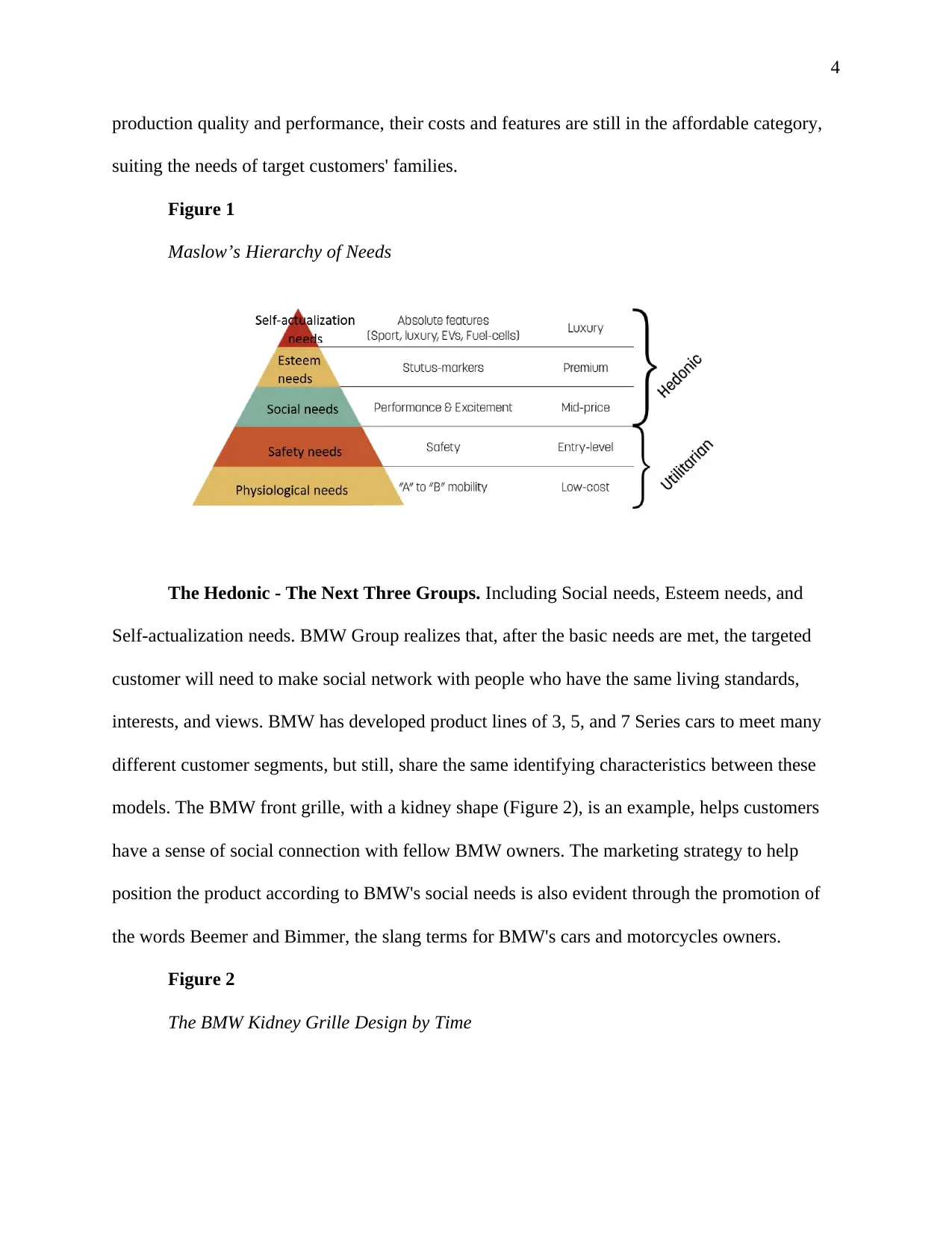
4
production quality and performance, their costs and features are still in the affordable category,
suiting the needs of target customers' families.
Figure 1
Maslow’s Hierarchy of Needs
The Hedonic - The Next Three Groups. Including Social needs, Esteem needs, and
Self-actualization needs. BMW Group realizes that, after the basic needs are met, the targeted
customer will need to make social network with people who have the same living standards,
interests, and views. BMW has developed product lines of 3, 5, and 7 Series cars to meet many
different customer segments, but still, share the same identifying characteristics between these
models. The BMW front grille, with a kidney shape (Figure 2), is an example, helps customers
have a sense of social connection with fellow BMW owners. The marketing strategy to help
position the product according to BMW's social needs is also evident through the promotion of
the words Beemer and Bimmer, the slang terms for BMW's cars and motorcycles owners.
Figure 2
The BMW Kidney Grille Design by Time
production quality and performance, their costs and features are still in the affordable category,
suiting the needs of target customers' families.
Figure 1
Maslow’s Hierarchy of Needs
The Hedonic - The Next Three Groups. Including Social needs, Esteem needs, and
Self-actualization needs. BMW Group realizes that, after the basic needs are met, the targeted
customer will need to make social network with people who have the same living standards,
interests, and views. BMW has developed product lines of 3, 5, and 7 Series cars to meet many
different customer segments, but still, share the same identifying characteristics between these
models. The BMW front grille, with a kidney shape (Figure 2), is an example, helps customers
have a sense of social connection with fellow BMW owners. The marketing strategy to help
position the product according to BMW's social needs is also evident through the promotion of
the words Beemer and Bimmer, the slang terms for BMW's cars and motorcycles owners.
Figure 2
The BMW Kidney Grille Design by Time
Paraphrase This Document
Need a fresh take? Get an instant paraphrase of this document with our AI Paraphraser
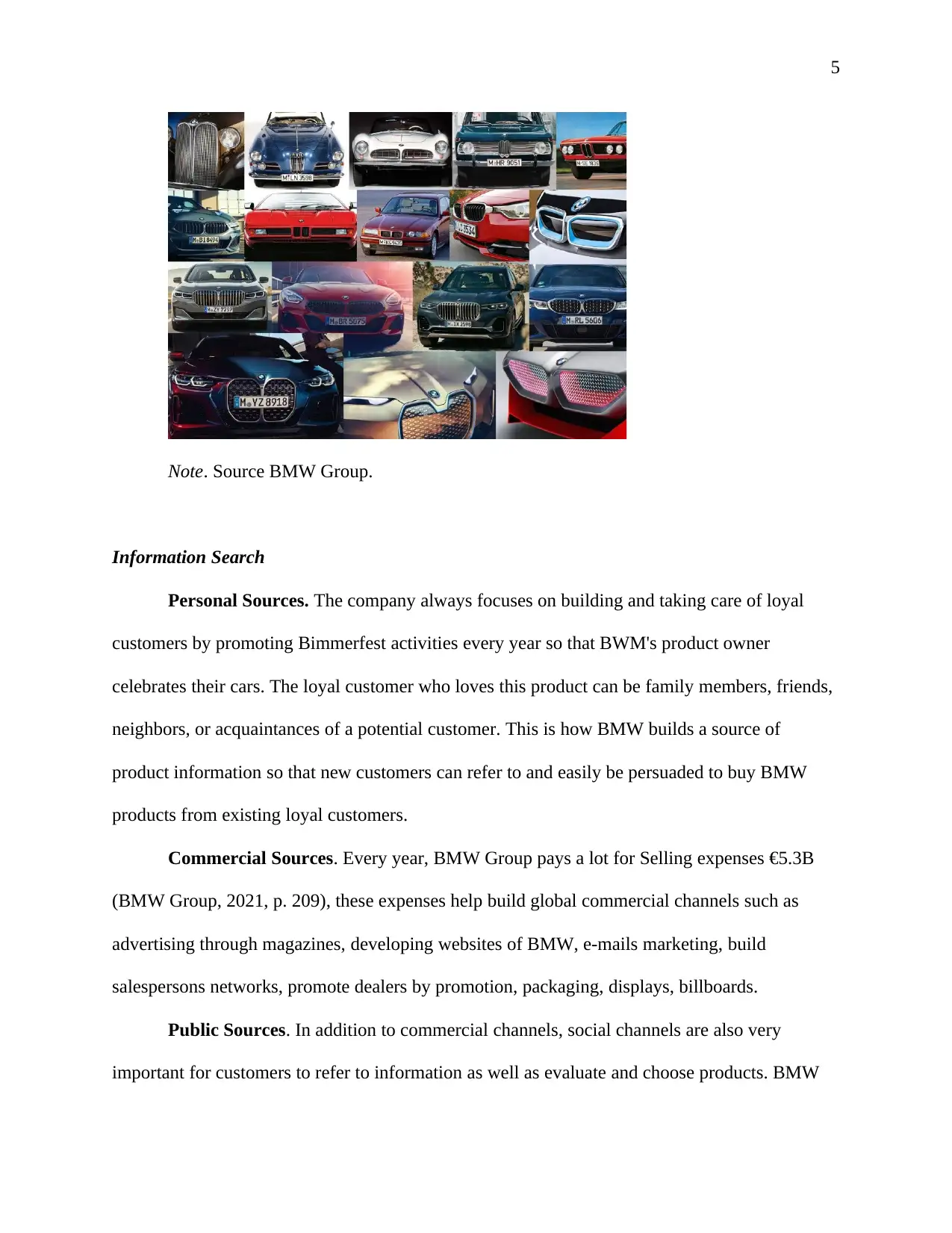
5
Note. Source BMW Group.
Information Search
Personal Sources. The company always focuses on building and taking care of loyal
customers by promoting Bimmerfest activities every year so that BWM's product owner
celebrates their cars. The loyal customer who loves this product can be family members, friends,
neighbors, or acquaintances of a potential customer. This is how BMW builds a source of
product information so that new customers can refer to and easily be persuaded to buy BMW
products from existing loyal customers.
Commercial Sources. Every year, BMW Group pays a lot for Selling expenses €5.3B
(BMW Group, 2021, p. 209), these expenses help build global commercial channels such as
advertising through magazines, developing websites of BMW, e-mails marketing, build
salespersons networks, promote dealers by promotion, packaging, displays, billboards.
Public Sources. In addition to commercial channels, social channels are also very
important for customers to refer to information as well as evaluate and choose products. BMW
Note. Source BMW Group.
Information Search
Personal Sources. The company always focuses on building and taking care of loyal
customers by promoting Bimmerfest activities every year so that BWM's product owner
celebrates their cars. The loyal customer who loves this product can be family members, friends,
neighbors, or acquaintances of a potential customer. This is how BMW builds a source of
product information so that new customers can refer to and easily be persuaded to buy BMW
products from existing loyal customers.
Commercial Sources. Every year, BMW Group pays a lot for Selling expenses €5.3B
(BMW Group, 2021, p. 209), these expenses help build global commercial channels such as
advertising through magazines, developing websites of BMW, e-mails marketing, build
salespersons networks, promote dealers by promotion, packaging, displays, billboards.
Public Sources. In addition to commercial channels, social channels are also very
important for customers to refer to information as well as evaluate and choose products. BMW
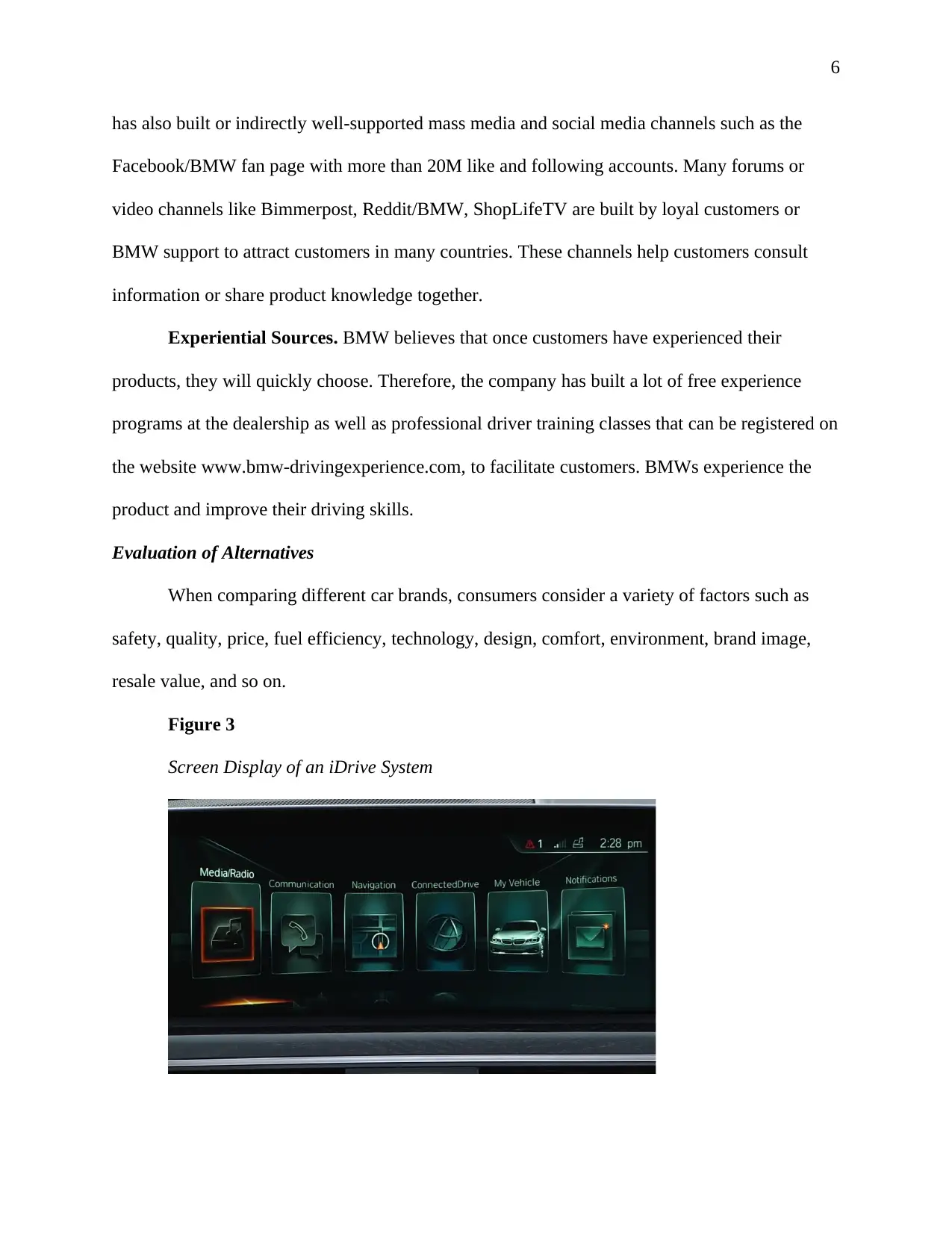
6
has also built or indirectly well-supported mass media and social media channels such as the
Facebook/BMW fan page with more than 20M like and following accounts. Many forums or
video channels like Bimmerpost, Reddit/BMW, ShopLifeTV are built by loyal customers or
BMW support to attract customers in many countries. These channels help customers consult
information or share product knowledge together.
Experiential Sources. BMW believes that once customers have experienced their
products, they will quickly choose. Therefore, the company has built a lot of free experience
programs at the dealership as well as professional driver training classes that can be registered on
the website www.bmw-drivingexperience.com, to facilitate customers. BMWs experience the
product and improve their driving skills.
Evaluation of Alternatives
When comparing different car brands, consumers consider a variety of factors such as
safety, quality, price, fuel efficiency, technology, design, comfort, environment, brand image,
resale value, and so on.
Figure 3
Screen Display of an iDrive System
has also built or indirectly well-supported mass media and social media channels such as the
Facebook/BMW fan page with more than 20M like and following accounts. Many forums or
video channels like Bimmerpost, Reddit/BMW, ShopLifeTV are built by loyal customers or
BMW support to attract customers in many countries. These channels help customers consult
information or share product knowledge together.
Experiential Sources. BMW believes that once customers have experienced their
products, they will quickly choose. Therefore, the company has built a lot of free experience
programs at the dealership as well as professional driver training classes that can be registered on
the website www.bmw-drivingexperience.com, to facilitate customers. BMWs experience the
product and improve their driving skills.
Evaluation of Alternatives
When comparing different car brands, consumers consider a variety of factors such as
safety, quality, price, fuel efficiency, technology, design, comfort, environment, brand image,
resale value, and so on.
Figure 3
Screen Display of an iDrive System
⊘ This is a preview!⊘
Do you want full access?
Subscribe today to unlock all pages.

Trusted by 1+ million students worldwide
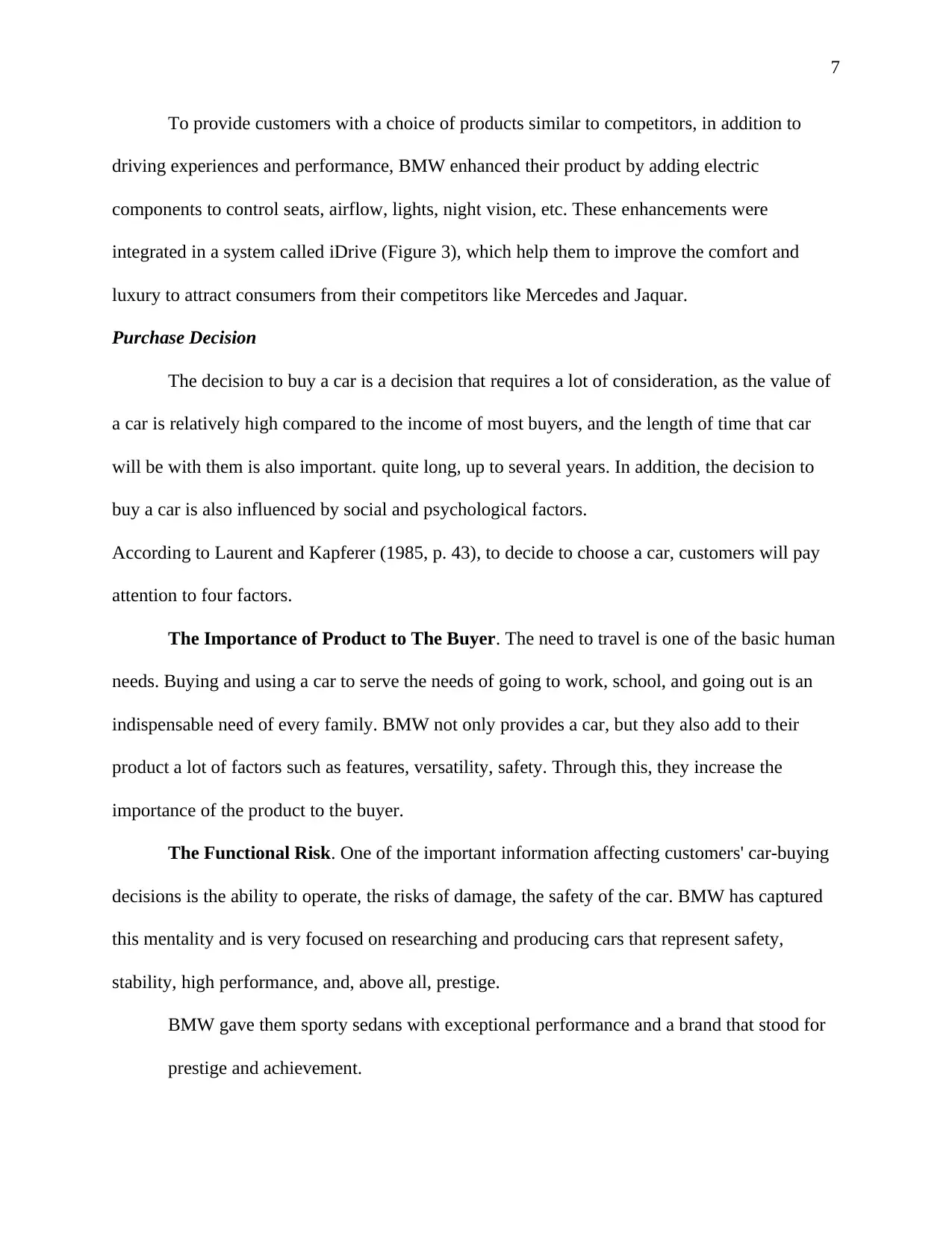
7
To provide customers with a choice of products similar to competitors, in addition to
driving experiences and performance, BMW enhanced their product by adding electric
components to control seats, airflow, lights, night vision, etc. These enhancements were
integrated in a system called iDrive (Figure 3), which help them to improve the comfort and
luxury to attract consumers from their competitors like Mercedes and Jaquar.
Purchase Decision
The decision to buy a car is a decision that requires a lot of consideration, as the value of
a car is relatively high compared to the income of most buyers, and the length of time that car
will be with them is also important. quite long, up to several years. In addition, the decision to
buy a car is also influenced by social and psychological factors.
According to Laurent and Kapferer (1985, p. 43), to decide to choose a car, customers will pay
attention to four factors.
The Importance of Product to The Buyer. The need to travel is one of the basic human
needs. Buying and using a car to serve the needs of going to work, school, and going out is an
indispensable need of every family. BMW not only provides a car, but they also add to their
product a lot of factors such as features, versatility, safety. Through this, they increase the
importance of the product to the buyer.
The Functional Risk. One of the important information affecting customers' car-buying
decisions is the ability to operate, the risks of damage, the safety of the car. BMW has captured
this mentality and is very focused on researching and producing cars that represent safety,
stability, high performance, and, above all, prestige.
BMW gave them sporty sedans with exceptional performance and a brand that stood for
prestige and achievement.
To provide customers with a choice of products similar to competitors, in addition to
driving experiences and performance, BMW enhanced their product by adding electric
components to control seats, airflow, lights, night vision, etc. These enhancements were
integrated in a system called iDrive (Figure 3), which help them to improve the comfort and
luxury to attract consumers from their competitors like Mercedes and Jaquar.
Purchase Decision
The decision to buy a car is a decision that requires a lot of consideration, as the value of
a car is relatively high compared to the income of most buyers, and the length of time that car
will be with them is also important. quite long, up to several years. In addition, the decision to
buy a car is also influenced by social and psychological factors.
According to Laurent and Kapferer (1985, p. 43), to decide to choose a car, customers will pay
attention to four factors.
The Importance of Product to The Buyer. The need to travel is one of the basic human
needs. Buying and using a car to serve the needs of going to work, school, and going out is an
indispensable need of every family. BMW not only provides a car, but they also add to their
product a lot of factors such as features, versatility, safety. Through this, they increase the
importance of the product to the buyer.
The Functional Risk. One of the important information affecting customers' car-buying
decisions is the ability to operate, the risks of damage, the safety of the car. BMW has captured
this mentality and is very focused on researching and producing cars that represent safety,
stability, high performance, and, above all, prestige.
BMW gave them sporty sedans with exceptional performance and a brand that stood for
prestige and achievement.
Paraphrase This Document
Need a fresh take? Get an instant paraphrase of this document with our AI Paraphraser
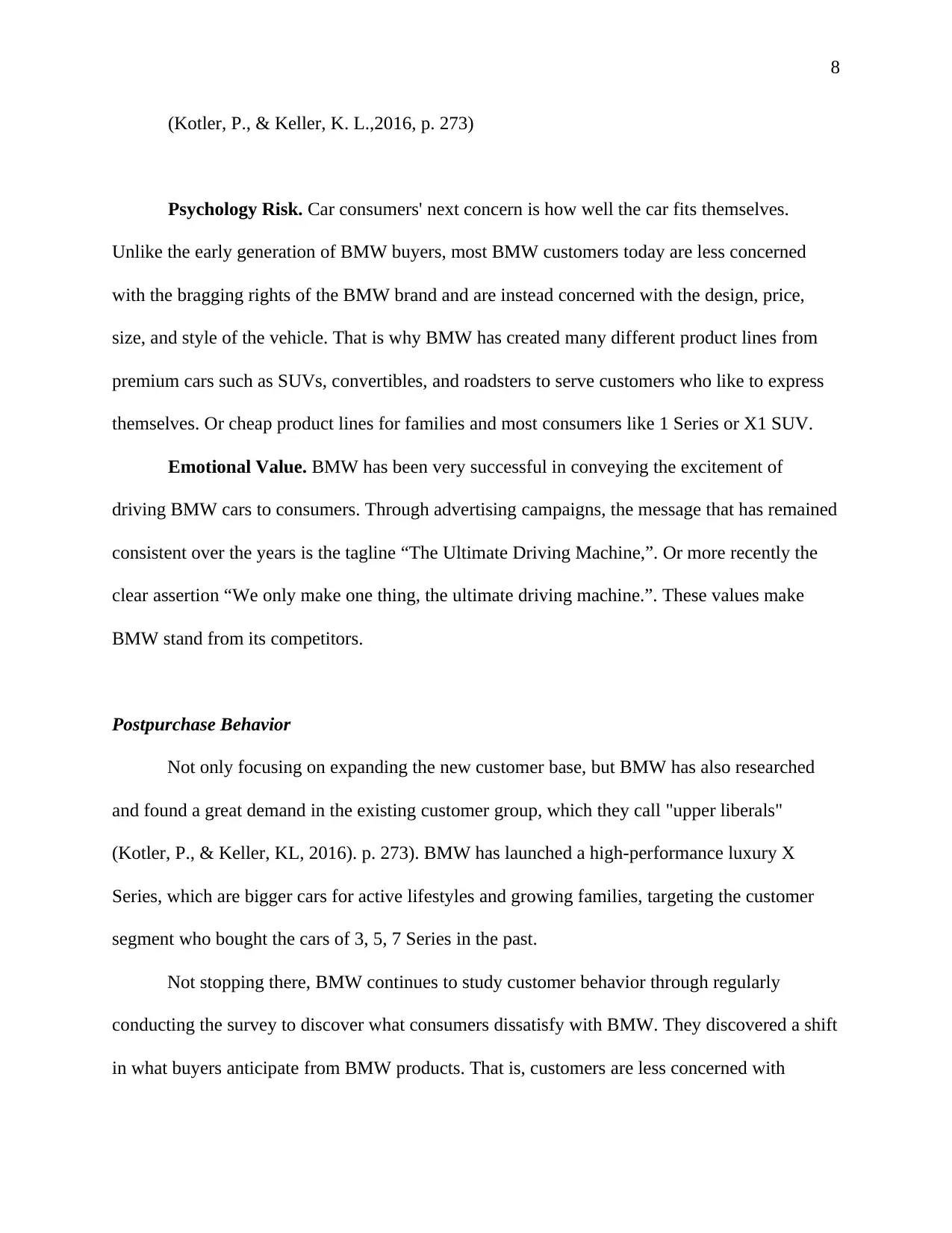
8
(Kotler, P., & Keller, K. L.,2016, p. 273)
Psychology Risk. Car consumers' next concern is how well the car fits themselves.
Unlike the early generation of BMW buyers, most BMW customers today are less concerned
with the bragging rights of the BMW brand and are instead concerned with the design, price,
size, and style of the vehicle. That is why BMW has created many different product lines from
premium cars such as SUVs, convertibles, and roadsters to serve customers who like to express
themselves. Or cheap product lines for families and most consumers like 1 Series or X1 SUV.
Emotional Value. BMW has been very successful in conveying the excitement of
driving BMW cars to consumers. Through advertising campaigns, the message that has remained
consistent over the years is the tagline “The Ultimate Driving Machine,”. Or more recently the
clear assertion “We only make one thing, the ultimate driving machine.”. These values make
BMW stand from its competitors.
Postpurchase Behavior
Not only focusing on expanding the new customer base, but BMW has also researched
and found a great demand in the existing customer group, which they call "upper liberals"
(Kotler, P., & Keller, KL, 2016). p. 273). BMW has launched a high-performance luxury X
Series, which are bigger cars for active lifestyles and growing families, targeting the customer
segment who bought the cars of 3, 5, 7 Series in the past.
Not stopping there, BMW continues to study customer behavior through regularly
conducting the survey to discover what consumers dissatisfy with BMW. They discovered a shift
in what buyers anticipate from BMW products. That is, customers are less concerned with
(Kotler, P., & Keller, K. L.,2016, p. 273)
Psychology Risk. Car consumers' next concern is how well the car fits themselves.
Unlike the early generation of BMW buyers, most BMW customers today are less concerned
with the bragging rights of the BMW brand and are instead concerned with the design, price,
size, and style of the vehicle. That is why BMW has created many different product lines from
premium cars such as SUVs, convertibles, and roadsters to serve customers who like to express
themselves. Or cheap product lines for families and most consumers like 1 Series or X1 SUV.
Emotional Value. BMW has been very successful in conveying the excitement of
driving BMW cars to consumers. Through advertising campaigns, the message that has remained
consistent over the years is the tagline “The Ultimate Driving Machine,”. Or more recently the
clear assertion “We only make one thing, the ultimate driving machine.”. These values make
BMW stand from its competitors.
Postpurchase Behavior
Not only focusing on expanding the new customer base, but BMW has also researched
and found a great demand in the existing customer group, which they call "upper liberals"
(Kotler, P., & Keller, KL, 2016). p. 273). BMW has launched a high-performance luxury X
Series, which are bigger cars for active lifestyles and growing families, targeting the customer
segment who bought the cars of 3, 5, 7 Series in the past.
Not stopping there, BMW continues to study customer behavior through regularly
conducting the survey to discover what consumers dissatisfy with BMW. They discovered a shift
in what buyers anticipate from BMW products. That is, customers are less concerned with
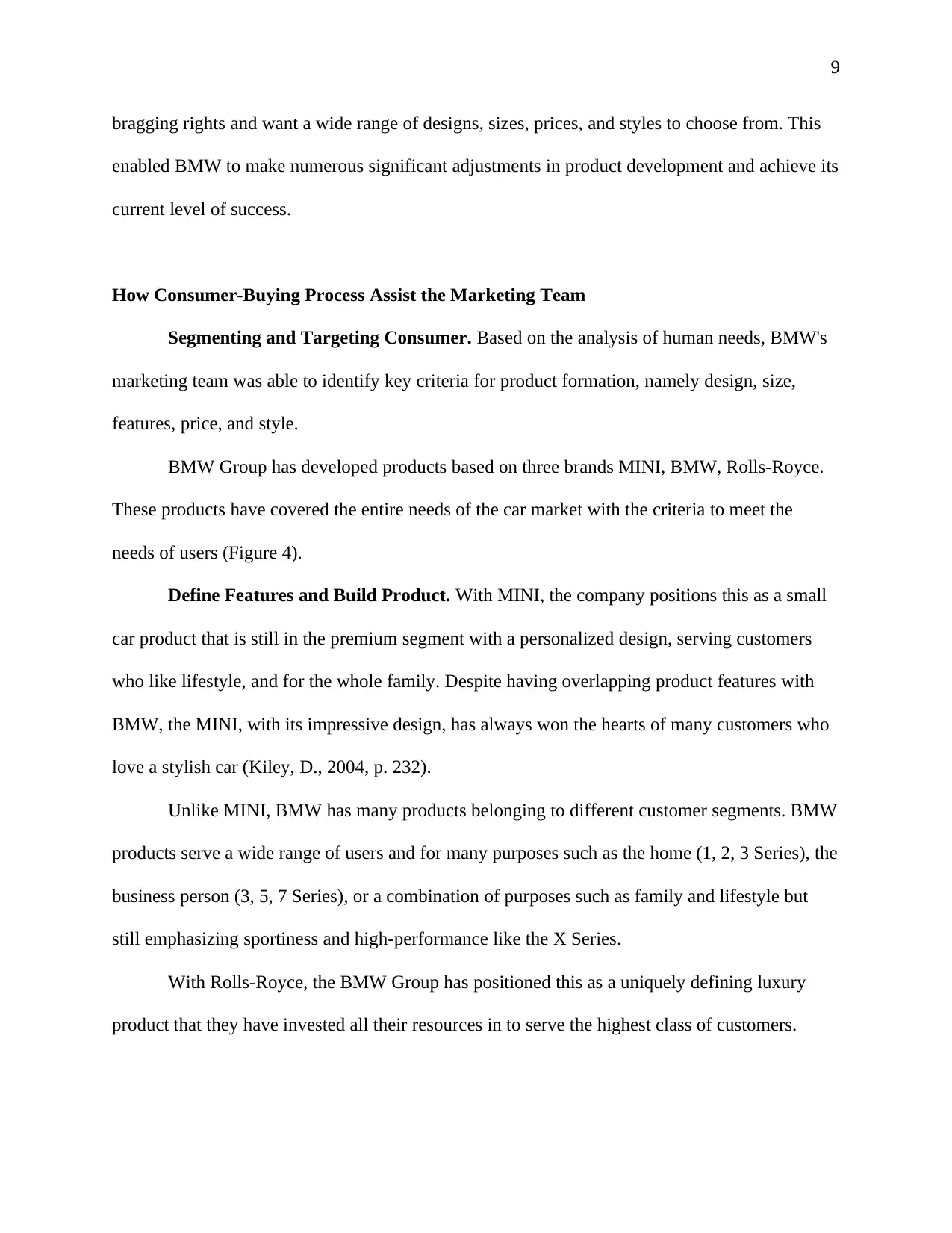
9
bragging rights and want a wide range of designs, sizes, prices, and styles to choose from. This
enabled BMW to make numerous significant adjustments in product development and achieve its
current level of success.
How Consumer-Buying Process Assist the Marketing Team
Segmenting and Targeting Consumer. Based on the analysis of human needs, BMW's
marketing team was able to identify key criteria for product formation, namely design, size,
features, price, and style.
BMW Group has developed products based on three brands MINI, BMW, Rolls-Royce.
These products have covered the entire needs of the car market with the criteria to meet the
needs of users (Figure 4).
Define Features and Build Product. With MINI, the company positions this as a small
car product that is still in the premium segment with a personalized design, serving customers
who like lifestyle, and for the whole family. Despite having overlapping product features with
BMW, the MINI, with its impressive design, has always won the hearts of many customers who
love a stylish car (Kiley, D., 2004, p. 232).
Unlike MINI, BMW has many products belonging to different customer segments. BMW
products serve a wide range of users and for many purposes such as the home (1, 2, 3 Series), the
business person (3, 5, 7 Series), or a combination of purposes such as family and lifestyle but
still emphasizing sportiness and high-performance like the X Series.
With Rolls-Royce, the BMW Group has positioned this as a uniquely defining luxury
product that they have invested all their resources in to serve the highest class of customers.
bragging rights and want a wide range of designs, sizes, prices, and styles to choose from. This
enabled BMW to make numerous significant adjustments in product development and achieve its
current level of success.
How Consumer-Buying Process Assist the Marketing Team
Segmenting and Targeting Consumer. Based on the analysis of human needs, BMW's
marketing team was able to identify key criteria for product formation, namely design, size,
features, price, and style.
BMW Group has developed products based on three brands MINI, BMW, Rolls-Royce.
These products have covered the entire needs of the car market with the criteria to meet the
needs of users (Figure 4).
Define Features and Build Product. With MINI, the company positions this as a small
car product that is still in the premium segment with a personalized design, serving customers
who like lifestyle, and for the whole family. Despite having overlapping product features with
BMW, the MINI, with its impressive design, has always won the hearts of many customers who
love a stylish car (Kiley, D., 2004, p. 232).
Unlike MINI, BMW has many products belonging to different customer segments. BMW
products serve a wide range of users and for many purposes such as the home (1, 2, 3 Series), the
business person (3, 5, 7 Series), or a combination of purposes such as family and lifestyle but
still emphasizing sportiness and high-performance like the X Series.
With Rolls-Royce, the BMW Group has positioned this as a uniquely defining luxury
product that they have invested all their resources in to serve the highest class of customers.
⊘ This is a preview!⊘
Do you want full access?
Subscribe today to unlock all pages.

Trusted by 1+ million students worldwide
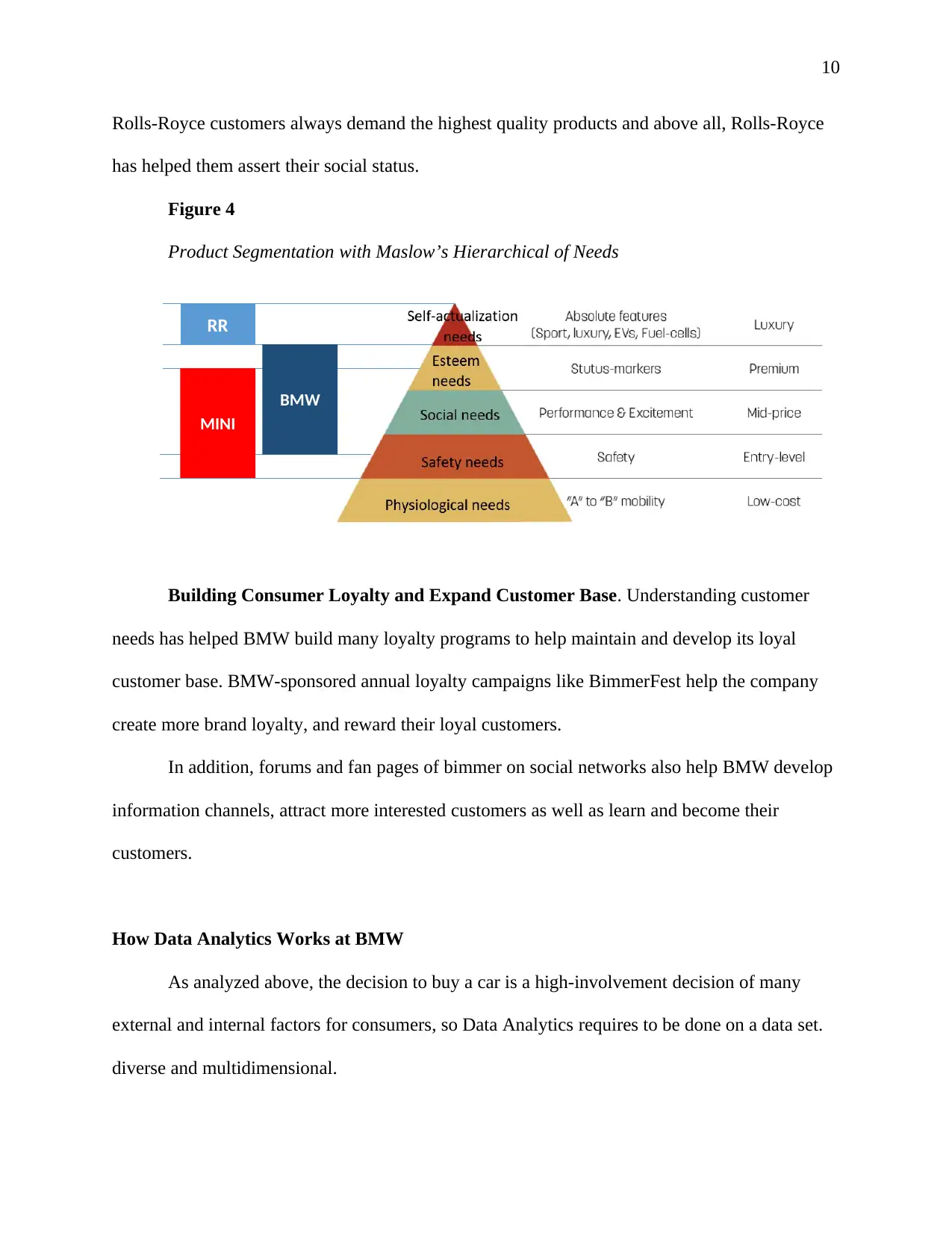
10
Rolls-Royce customers always demand the highest quality products and above all, Rolls-Royce
has helped them assert their social status.
Figure 4
Product Segmentation with Maslow’s Hierarchical of Needs
Building Consumer Loyalty and Expand Customer Base. Understanding customer
needs has helped BMW build many loyalty programs to help maintain and develop its loyal
customer base. BMW-sponsored annual loyalty campaigns like BimmerFest help the company
create more brand loyalty, and reward their loyal customers.
In addition, forums and fan pages of bimmer on social networks also help BMW develop
information channels, attract more interested customers as well as learn and become their
customers.
How Data Analytics Works at BMW
As analyzed above, the decision to buy a car is a high-involvement decision of many
external and internal factors for consumers, so Data Analytics requires to be done on a data set.
diverse and multidimensional.
RR
BMW
MINI
Rolls-Royce customers always demand the highest quality products and above all, Rolls-Royce
has helped them assert their social status.
Figure 4
Product Segmentation with Maslow’s Hierarchical of Needs
Building Consumer Loyalty and Expand Customer Base. Understanding customer
needs has helped BMW build many loyalty programs to help maintain and develop its loyal
customer base. BMW-sponsored annual loyalty campaigns like BimmerFest help the company
create more brand loyalty, and reward their loyal customers.
In addition, forums and fan pages of bimmer on social networks also help BMW develop
information channels, attract more interested customers as well as learn and become their
customers.
How Data Analytics Works at BMW
As analyzed above, the decision to buy a car is a high-involvement decision of many
external and internal factors for consumers, so Data Analytics requires to be done on a data set.
diverse and multidimensional.
RR
BMW
MINI
Paraphrase This Document
Need a fresh take? Get an instant paraphrase of this document with our AI Paraphraser
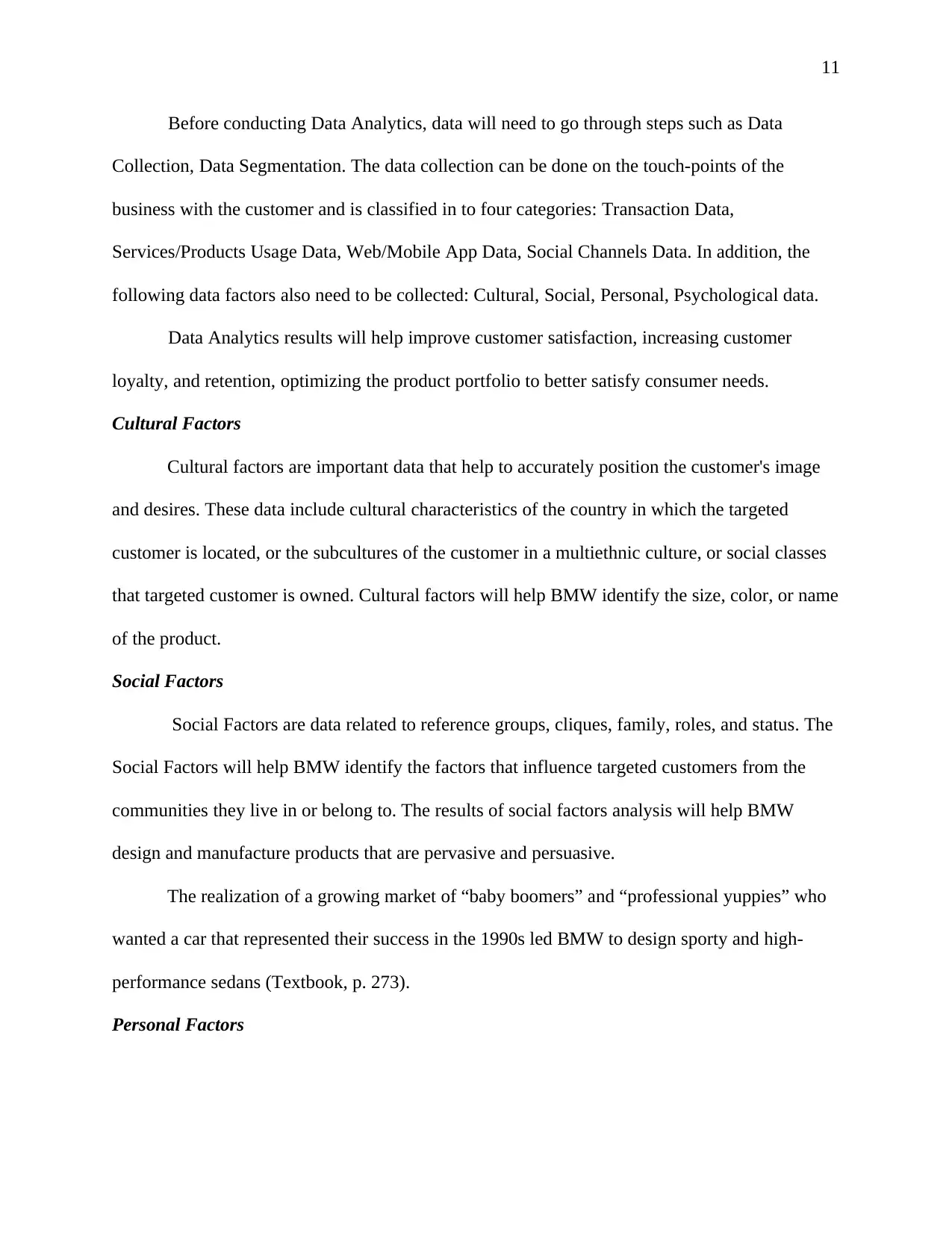
11
Before conducting Data Analytics, data will need to go through steps such as Data
Collection, Data Segmentation. The data collection can be done on the touch-points of the
business with the customer and is classified in to four categories: Transaction Data,
Services/Products Usage Data, Web/Mobile App Data, Social Channels Data. In addition, the
following data factors also need to be collected: Cultural, Social, Personal, Psychological data.
Data Analytics results will help improve customer satisfaction, increasing customer
loyalty, and retention, optimizing the product portfolio to better satisfy consumer needs.
Cultural Factors
Cultural factors are important data that help to accurately position the customer's image
and desires. These data include cultural characteristics of the country in which the targeted
customer is located, or the subcultures of the customer in a multiethnic culture, or social classes
that targeted customer is owned. Cultural factors will help BMW identify the size, color, or name
of the product.
Social Factors
Social Factors are data related to reference groups, cliques, family, roles, and status. The
Social Factors will help BMW identify the factors that influence targeted customers from the
communities they live in or belong to. The results of social factors analysis will help BMW
design and manufacture products that are pervasive and persuasive.
The realization of a growing market of “baby boomers” and “professional yuppies” who
wanted a car that represented their success in the 1990s led BMW to design sporty and high-
performance sedans (Textbook, p. 273).
Personal Factors
Before conducting Data Analytics, data will need to go through steps such as Data
Collection, Data Segmentation. The data collection can be done on the touch-points of the
business with the customer and is classified in to four categories: Transaction Data,
Services/Products Usage Data, Web/Mobile App Data, Social Channels Data. In addition, the
following data factors also need to be collected: Cultural, Social, Personal, Psychological data.
Data Analytics results will help improve customer satisfaction, increasing customer
loyalty, and retention, optimizing the product portfolio to better satisfy consumer needs.
Cultural Factors
Cultural factors are important data that help to accurately position the customer's image
and desires. These data include cultural characteristics of the country in which the targeted
customer is located, or the subcultures of the customer in a multiethnic culture, or social classes
that targeted customer is owned. Cultural factors will help BMW identify the size, color, or name
of the product.
Social Factors
Social Factors are data related to reference groups, cliques, family, roles, and status. The
Social Factors will help BMW identify the factors that influence targeted customers from the
communities they live in or belong to. The results of social factors analysis will help BMW
design and manufacture products that are pervasive and persuasive.
The realization of a growing market of “baby boomers” and “professional yuppies” who
wanted a car that represented their success in the 1990s led BMW to design sporty and high-
performance sedans (Textbook, p. 273).
Personal Factors

12
Collecting personal factors analysis BMW will have information including age, stage in
the life cycle, occupation and economic circumstances, personality and self-concept, lifestyle,
and values. This information plays an important role in developing highly personalized products,
creating marketing campaigns with the right customer psychology.
As shown in the Textbook (p. 273), in the 1990s, BMW conducted customer research and
discovered that consumers were less concerned with the BMW brand's bragging rights and
preferred a wide range of designs, sizes, pricing, and styles.
Psychological Factors
Factors that form psychological factors include motivation, perception, learning,
emotions, and memory. The results of psychological factors analysis will help BMW identify the
factors that contribute to the decision to buy its products. From there the company can create
products with outstanding features that can beat their direct competitors in the purchase decision
stage.
Review BMW’ Segmentation & Targeting Activities
BMW is a car company with a global market. Since the 1980s, BMW has researched and
developed products to approach the global market, following the globalization trend of the world
economy. The customer segments that BMW is interested in extending beyond a country or a
territory.
BMW Done Well
BMW succeeded in combine different variables to segment consumers.
Demographic Segmentation. Based on the results of market research, BMW realized the
growing market of “baby boomers” and “professional yuppies” in the 1990s. The company
Collecting personal factors analysis BMW will have information including age, stage in
the life cycle, occupation and economic circumstances, personality and self-concept, lifestyle,
and values. This information plays an important role in developing highly personalized products,
creating marketing campaigns with the right customer psychology.
As shown in the Textbook (p. 273), in the 1990s, BMW conducted customer research and
discovered that consumers were less concerned with the BMW brand's bragging rights and
preferred a wide range of designs, sizes, pricing, and styles.
Psychological Factors
Factors that form psychological factors include motivation, perception, learning,
emotions, and memory. The results of psychological factors analysis will help BMW identify the
factors that contribute to the decision to buy its products. From there the company can create
products with outstanding features that can beat their direct competitors in the purchase decision
stage.
Review BMW’ Segmentation & Targeting Activities
BMW is a car company with a global market. Since the 1980s, BMW has researched and
developed products to approach the global market, following the globalization trend of the world
economy. The customer segments that BMW is interested in extending beyond a country or a
territory.
BMW Done Well
BMW succeeded in combine different variables to segment consumers.
Demographic Segmentation. Based on the results of market research, BMW realized the
growing market of “baby boomers” and “professional yuppies” in the 1990s. The company
⊘ This is a preview!⊘
Do you want full access?
Subscribe today to unlock all pages.

Trusted by 1+ million students worldwide
1 out of 37
Related Documents
Your All-in-One AI-Powered Toolkit for Academic Success.
+13062052269
info@desklib.com
Available 24*7 on WhatsApp / Email
![[object Object]](/_next/static/media/star-bottom.7253800d.svg)
Unlock your academic potential
Copyright © 2020–2026 A2Z Services. All Rights Reserved. Developed and managed by ZUCOL.


